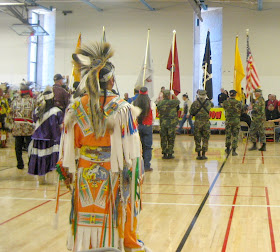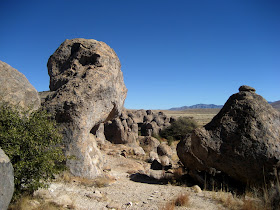 |
| Gaan dancers from Mescalero. Alamogordo, New Mexico. Credit: John Bear |
The Red Paint Powwow is an annual event in Silver City, New Mexico, hosted by the Chiricahua Apache. I attended the powwow on Saturday, January 19, 2013.
It's probably irreverent to say this, but I'll say it anyway - the Apache Gaan dancers are the coolest-looking.
Also known as Ga'an dancers, Crown dancers, or Mountain Spirit dancers, all of their dances are considered sacred.
 |
| Gaan dancers. Credit: SFMOMA |
Amendment: I get the impression that in some venues, they modify their song and movements so as not to compromise the dancers' responsibility to protect the sanctity of the Gaan rite.
The story
An excerpt from Native Peoples of the Southwest, Trudy Griffin Pierce, University of New Mexico Press, 2000, ISBN: 0-8263-1907-6:
"One of the most important holy beings for Apaches is White-Painted Woman, also known as Changing Woman or White Shell Woman. Her sons, Killer of Enemies and Child Born of Water, triumphed over the evils of the world personified as monsters, making the world safe for humans. The Mountain Spirits ensure the well-being of the people by protecting them from epidemic diseases and enemies. The Mountain Spirit Dancers or Crown Dancers "become" these sacred beings in the same way that the Hopi who dance specific katsinam become those katsina spirits. ... Their heads crowned with wooden slat headdresses, four Mountain Spirit Dancers and a clown wield their wooden swords as they dance around the fire. The bull-roarer, which is whirled on a length of string to produce a distinctive, resonating sound, drums, and singing accompany their dancing among the Western Apache. The bull-roarer is not used among the Eastern Apache."
Not mentioned above is the vocal sound made by some of the dancers at different intervals - to me, it sounds similar to, but not exactly, like a western screech owl.
In the video below, from an Arizona event, you can hear both the bird (?) call and the so-called "bull-roarer." You'll hear the bird vocalization while the dancers first come out. You'll hear the start of the bull-roarer at :51.
The dancer with the bull-roarer is The Clown. From Native American Culture: About Apache Dances, an excerpt:
"There are five Crown Dancers, including four masked dancers representing the directions of north, south, east, and west. The fifth dancer is the clown, who protects the others by driving away evil spirits with the sound of his humming bull-roarer, a thin piece of wood suspended from a string and swung in a circle."
To fully address the role of the Clown in Navajo, Apache, and indeed, many cultures (though perhaps not specifically referred to as a clown), I'd need to just hand over a book. Or books. Tony Hillerman centers one of his books around clowns in Sacred Clowns.
As to Apache tradition, in this excerpt from The Clown's Way, by Barbara Tedlock:
"The Jicarilla Apache, however, did not see this sunlight world purely good, but as containing disease; the clown that led them out of the dark earth (thought of as perfectly spiritual and holy) was equipped with a “horrible non-human laugh” which scared way the sickness on the earth’s surface. In this origin story we learn a basic curing technique which is still practiced today by clowns in many tribes. Just as these Apache clowns kept smallpox and other epidemics away from the people with their sudden terrifying laugh, the Assiniboine, Plains Cree, and Plains Ojibwa clowns scare disease out of the people. Navajo clowns during their Mud Dance all of a sudden stop dancing and rush up to a sick person and lift him high above their heads, sometimes tossing him into the air.”
I'm wondering if the rodeo clown derives from the Southwestern Indians' use of the clown in their spiritual tradition. After all, the purpose of the rodeo clown is to protect the riders from the bulls or horses, is it not? Huh, this resource implies not, but when I read the full description, it would seem the rodeo clowns share much in common with that of the Indian clown, although without the spiritual dimension.
 |
| Gaan dancers, 1887. Credit: First People |
The crown
Another excerpt from Native American Culture: About Apache Dances:
"The dancers decide what symbols to put on their crowns. Symbols often honor forms in nature, and many crowns include the Apache cross to signify the four sacred directions. Some crown headdresses are adorned with eagle feathers, because the eagle is sacred to the Apache. ..."
 |
| St. Joseph Apache Mission Church, Mescalero, New Mexico |
My understanding is that the crown itself evokes antlers.
I liked how the St. Joseph Apache Mission Church in Mescalero incorporated traditional crown design.
Noah Nez, the Native Skeptic, offers a thorough overview on Gaan dancers from both a personal and academic perspective. I found several of the sources for my post by visiting his essay.
My experience
The Gaan dancers are dramatic. With their bodies painted white or black, with contrasting color symbols, masked faces, the crown, swords, and the bird call .....whew. Very cool.
The emcee did not instruct the audience to forego photography during the Gaan dance, which he did for the gourd dance. I filmed the dancers as they came into the arena, and the gentleman next to me, a gourd dancer, asked that I not film them. I chose to honor his request, out of respect for him. I had watched as he'd very carefully placed his gourd-dance items into the specially-made wooden box, one at at time, each in a prescribed spot and placement. I saw memorial flyers on the inside of the box lid, honoring two deceased individuals he obviously held in esteem.
I'm looking forward to the summer, when the Mescalero Apaches allow non-Apaches to be guests at part of the girls' puberty rite in Mescalero, and when the Gaan dancers will perform.











































